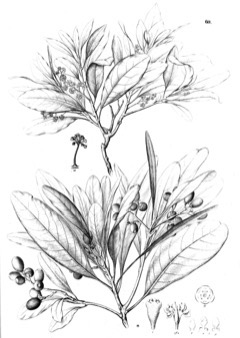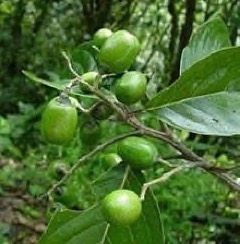 |
|
http://www.edibleplants.org |
 |
| wikimedia.org |
Translate this page:
Summary
Mezilaurus itauba or Itauba is a large, tropical, slow-growing, evergreen tree growing about 20 - 40 m tall and 60 - 80 cm in trunk diameter. It can be found in South America. It has a round crown. The bark yields an essential oil containing apiol that may cause abortion in pregnant women. The edible fruit is an ellipsoidal berry. The wood is heavy, highly durable, and resistant to attack of marine borer. Due to its high quality, the wood is used in external heavy construction, high class furniture, boat buildings, etc.
Physical Characteristics

 Mezilaurus itauba is an evergreen Tree growing to 30 m (98ft) by 25 m (82ft) at a medium rate.
Mezilaurus itauba is an evergreen Tree growing to 30 m (98ft) by 25 m (82ft) at a medium rate.
See above for USDA hardiness. It is hardy to UK zone 10.
Suitable for: light (sandy) and medium (loamy) soils, prefers well-drained soil and can grow in nutritionally poor soil. Suitable pH: mildly acid, neutral and basic (mildly alkaline) soils. It can grow in semi-shade (light woodland) or no shade. It prefers moist soil.
UK Hardiness Map
US Hardiness Map
Synonyms
Acrodiclidium anacardioides Meisn. Acrodiclidium itauba Meisn. Endiandra itauba (Meisn.) Benth. & Ho
Plant Habitats
Edible Uses
Edible Parts: Fruit
Edible Uses:
Fruit[444 ]. The fruit is an ellipsoid berry, around 2 x 1cm[444 ]. No more details.
References More on Edible Uses
Medicinal Uses
Plants For A Future can not take any responsibility for any adverse effects from the use of plants. Always seek advice from a professional before using a plant medicinally.
Abortifacient
The bark is used as an abortifacient[46 ].
References More on Medicinal Uses
The Bookshop: Edible Plant Books
Our Latest books on Perennial Plants For Food Forests and Permaculture Gardens in paperback or digital formats.

Edible Tropical Plants
Food Forest Plants for Hotter Conditions: 250+ Plants For Tropical Food Forests & Permaculture Gardens.
More

Edible Temperate Plants
Plants for Your Food Forest: 500 Plants for Temperate Food Forests & Permaculture Gardens.
More

More Books
PFAF have eight books available in paperback and digital formats. Browse the shop for more information.
Shop Now
Other Uses
Essential Furniture Wood
Other Uses An essential oil is obtained from the bark[46 ]. It contains apiol[46 ]. The heartwood is a yellow-brown to a dark, lustrous brown; it is not clearly demarcated from the 2 - 5cm wide band of sapwood. The texture is fine; the grain interlocked and sometimes wavy; the surface has an oily aspect. The wood is heavy; moderately hard to hard; elastic; very durable, being very resistant to fungi, dry wood borers and termites, and reported to be highly resistant to marine borer attack. It seasons slowly, with only a low risk of distortion but a high risk of checking; once dry it is moderately stable in service. It has a fairly high blunting effect, stellite-tipped and tungsten carbide tools are recommended; the interlocked grain means that it can be difficult to cut and to plane; nailing and screwing are good, but require pre-boring; gluing is correct for interior purposes only. A high quality wood, it is used sometimes as a substitute for teak (Tectona grandis). It is much used in external heavy construction for items such as bridges, railway ties, marine works, poles etc, for beams; and is also suitable for high class furniture, cabinet making, turnery etc; as well as for cart bodies, boat building, furniture components, joinery etc[341 , 420 , 444 , 848 ].
Special Uses
References More on Other Uses
Cultivation details
Succeeds in full sun or dappled shade[420 ]. Although a plant of primary forests, it regenerates easily in open areas[420 ].
References Carbon Farming Information and Carbon Sequestration Information
Temperature Converter
Type a value in the Celsius field to convert the value to Fahrenheit:
Fahrenheit:
The PFAF Bookshop
Plants For A Future have a number of books available in paperback and digital form. Book titles include Edible Plants, Edible Perennials, Edible Trees,Edible Shrubs, Woodland Gardening, and Temperate Food Forest Plants. Our new book is Food Forest Plants For Hotter Conditions (Tropical and Sub-Tropical).
Shop Now
Plant Propagation
Seed - best sown in a position in light shade, in individual containers, as soon as it is ripe[420 ]. Germination rates are usually low, occurring in 3 - 5 weeks[420 ]. Plants grow away slowly[420 ].
Other Names
If available other names are mentioned here
Itauba
Native Range
SOUTHERN AMERICA: French Guiana, Guyana, Suriname, Venezuela, Brazil (Acre, Amapá, Amazonas, Mato Grosso, Pará, Rondônia, Roraima), Bolivia, Colombia, Ecuador, Peru
Weed Potential
Right plant wrong place. We are currently updating this section.
Please note that a plant may be invasive in one area but may not in your area so it's worth checking.
Conservation Status
IUCN Red List of Threatened Plants Status : This taxon has not yet been assessed

Growth: S = slow M = medium F = fast. Soil: L = light (sandy) M = medium H = heavy (clay). pH: A = acid N = neutral B = basic (alkaline). Shade: F = full shade S = semi-shade N = no shade. Moisture: D = dry M = Moist We = wet Wa = water.
Now available:
Food Forest Plants for Mediterranean Conditions
350+ Perennial Plants For Mediterranean and Drier Food Forests and Permaculture Gardens.
[Paperback and eBook]
This is the third in Plants For A Future's series of plant guides for food forests tailored to
specific climate zones. Following volumes on temperate and tropical ecosystems, this book focuses
on species suited to Mediterranean conditions—regions with hot, dry summers and cool, wet winters,
often facing the added challenge of climate change.
Read More
Expert comment
Author
(Meisn.) Taub. ex Mez
Botanical References
Links / References
For a list of references used on this page please go here
A special thanks to Ken Fern for some of the information used on this page.
Readers comment
| Add a comment |
|
If you have important information about this plant that may help other users please add a comment or link below. Only comments or links that are felt to be directly relevant to a plant will be included. If you think a comment/link or information contained on this page is inaccurate or misleading we would welcome your feedback at [email protected]. If you have questions about a plant please use the Forum on this website as we do not have the resources to answer questions ourselves.
* Please note: the comments by website users are not necessarily those held by PFAF and may give misleading or inaccurate information.
To leave a comment please Register or login here All comments need to be approved so will not appear immediately.
|
Subject : Mezilaurus itauba
|
|
|
|